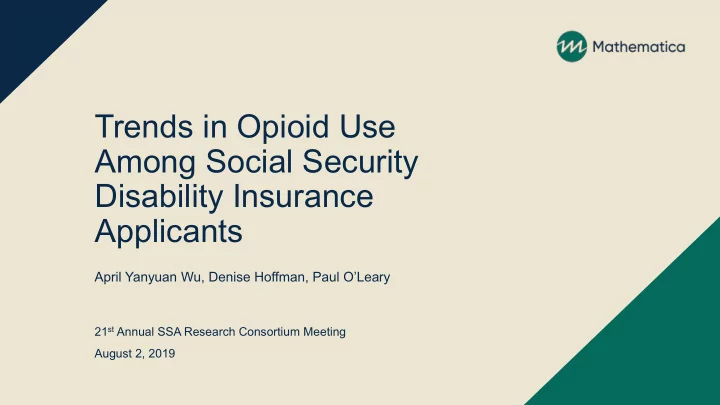

Trends in Opioid Use Among Social Security Disability Insurance Applicants April Yanyuan Wu, Denise Hoffman, Paul O’Leary 21 st Annual SSA Research Consortium Meeting August 2, 2019
Disclaimer The research reported herein was derived in whole or in part from research activities performed pursuant to a grant from the U.S. Social Security Administration (SSA), funded as part of the Retirement and Disability Research Consortium. The opinions and conclusions expressed are solely those of the authors and do not represent the opinions or policy of SSA, any agency of the federal government, Mathematica, or Boston College. 2
The Opioid Crisis and DI Applicants • Opioid use is prevalent in the United States • It’s unclear how opioids affect health and work capacity • Opioid use may be common among people applying for Social Security Disability Insurance (DI) • Opioid use among applicants has implications for the DI program 3
Most Medications Reported in Free-Text Fields Percentage of all medications reported via pull-down list versus free-text fields 70 60 50 40 30 20 2007 2008 2009 2010 2011 2012 2013 2014 2015 2016 2017 Pull-down list Free-text field Source: Authors’ calculations based on the 2007–2017 Structured Data Repository (SDR). 4
The Challenge: Free-Text Medication Data PIN MEDCN_CD MEDCN_DESC YEAR 0 zyprexa 1 2007 1 0 PAXIL Toprol 2007 183 1 2007 0 2 HYDRcodone 2009 343 2 2011 Relafen 0 percocet 3 2013 4 0 COLCHICINE 2013 0 i dont know because micheal cant remember 4 2013 0 Morphine-30mg/2xday 5 2017 o unknown 6 2017 5
Research Plan • Medication information from applications (SDR) • 30% sample of DI applicants in each year from 2007 to 2017 • About 6.5 million applications • Machine-learning approach to classify free-form text; also to classify medications from pull-down lists • Wu (2018) • Document trends in opioid use overall and by subgroups 6
Machine-Learning Algorithm: Spot On! 99% accuracy rate Source: Salian (2018). 7
Top 10 Most Commonly Reported Opioids Ranking Opioid substances Occurrences Fraction 1 Hydrocodone 485,750 16.1% 2 Tramadol 414,924 13.7% 3 Oxycodone 337,818 11.2% 4 Percocet 263,916 8.7% 5 Vicodin 226,346 7.5% 6 Norco 149,898 5.0% 7 Lortab 146,858 4.9% 8 Morphine 128,533 4.3% 9 OxyContin 71,739 2.4% 10 Ultram 53,218 1.8% Source: Authors’ calculations based on the 2007–2017 SDR. 8
Prevalence of Prescription Opioid Use Among DI Applicants 35% Percentage of DI applicants 28% 30% 26% reporting opioid use 32% 25% 20% 15% 10% 5% 0% 2007 2008 2009 2010 2011 2012 2013 2014 2015 2016 2017 Any opioid use 9
Prevalence of Prescription Opioid Use Among DI Applicants 35% Percentage of DI applicants 30% reporting opioid use 25% 20% 15% 10% 5% 0% 2007 2008 2009 2010 2011 2012 2013 2014 2015 2016 2017 Any opioid use One opioid Two opioids More than two opioids 10
Opioid Use Highest Among Certain Groups (2017) 35% Percentage of DI Applicants 30% Reporting Opioid Use, 25% 20% By Subgroup 15% 10% 5% 0% 11
Differences in Trends by Age 40% Reporting Opioid Use, By Age Percentage of DI Applicants 35% 30% 25% 20% 15% 10% 5% 0% 2007 2008 2009 2010 2011 2012 2013 2014 2015 2016 2017 18-29 30-39 40-49 50-59 60-67 12
Opioid Use Varied by State in 2007 13
…and in 2012… 14
…and in 2017 15
Conclusion • Successfully applied a machine learning algorithm to SSA administrative data • 99% accuracy rate Estimated 65% reduction in costs • • Opioid use is common among DI applicants • What causes changes in opioid use among applicants? • Trends in opioid-prescribing practices Changes in the composition of DI applicants • • DI application is an opportunity to connect opioid users with services 16
Future Research • What factors affect trends in opioid use among DI applicants? • What is the association between opioid use at application and DI award or death within five years? • Wu, Hoffman, O’Leary work in progress • What is the association between opioid use at application and subsequent employment outcomes? • Wu, Hoffman, O’Leary proposal • What are the trends in the use of mental health medication among applicants? • Application of Wu’s (2018) machine-learning algorithm 17
For More Information April Wu • AWu@mathematica-mpr.com Denise Hoffman • DHoffman@mathematica-mpr.com Paul O’Leary • Paul.OLeary@ssa.gov 18
Recommend
More recommend